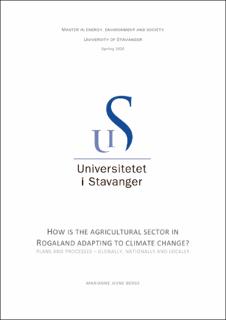| dc.contributor.advisor | Staupe-Delgado, Reidar | |
| dc.contributor.author | Berge, Marianne Jevne | |
| dc.coverage.spatial | Norway, Rogaland | en_US |
| dc.date.accessioned | 2020-10-08T09:17:34Z | |
| dc.date.available | 2020-10-08T09:17:34Z | |
| dc.date.issued | 2020-08 | |
| dc.identifier.uri | https://hdl.handle.net/11250/2681703 | |
| dc.description | Master's thesis in Energy, Environment & Society | en_US |
| dc.description.abstract | The purpose of this study is to investigate how the agricultural sector in Rogaland is adapting to climate change, and what factors affect decision-making in relation to this. Agriculture is especially vulnerable to climate change and adapting could reduce future impacts as well as benefit from arising opportunities. By using Rogaland county, a large agricultural county in Norway, I have seen how targets in international agreements are passed on to national and regional policies and plans, what factors affect decision-making in agricultural adaptation, and how the threat of climate change is interpreted by farmers and policymakers in Rogaland. These three questions are interrelated and can affect each other.
Ambitions and goals in international agreements are rarely literally mentioned in regional plans, but rather passed on through ideas and targets in national guidelines. Some international agreements and decisions are emphasized more than others, especially the sustainable development goals and the Paris agreement. Climate change adaptation is given more and more attention at the County Governor of Rogaland, and there is a wish to rather work with preventive measures than coping measures. Although agriculture is related to national food security, adaptation in agriculture is the individual farmers choice and not something the County Governor can instruct farmers to implement. The County Governor of Rogaland takes on a supporting role through grants, programs, compensation and support schemes.
The findings show that farmers in Rogaland acknowledge the threat of climate change and are aware of potential indirect and direct effects. Adapting to climate change and climate variability is understood as a process of continuously adjusting to changing conditions by implementing certain technologies, using government initiatives or alter different farm production practices. This process is influenced by external and internal forces mainly consisting of climatic stimuli in the form of heavy rainfall, socio-economic and political factors in the form of government initiatives and compensation schemes, technological innovations, and personal traits. | en_US |
| dc.language.iso | eng | en_US |
| dc.publisher | University of Stavanger, Norway | en_US |
| dc.relation.ispartofseries | Masteroppgave/UIS-SV-IMS/2020; | |
| dc.rights | Navngivelse 4.0 Internasjonal | * |
| dc.rights.uri | http://creativecommons.org/licenses/by/4.0/deed.no | * |
| dc.subject | klimaendringer | en_US |
| dc.subject | climate change | en_US |
| dc.subject | adaptation | en_US |
| dc.subject | agriculture | en_US |
| dc.subject | adaptive capacity | en_US |
| dc.subject | vulnerability | en_US |
| dc.subject | decision-making | en_US |
| dc.title | How is the agricultural sector in Rogaland adapting to climate change? Plans and processes - globally, nationally and locally | en_US |
| dc.type | Master thesis | en_US |
| dc.subject.nsi | VDP::Samfunnsvitenskap: 200 | en_US |

